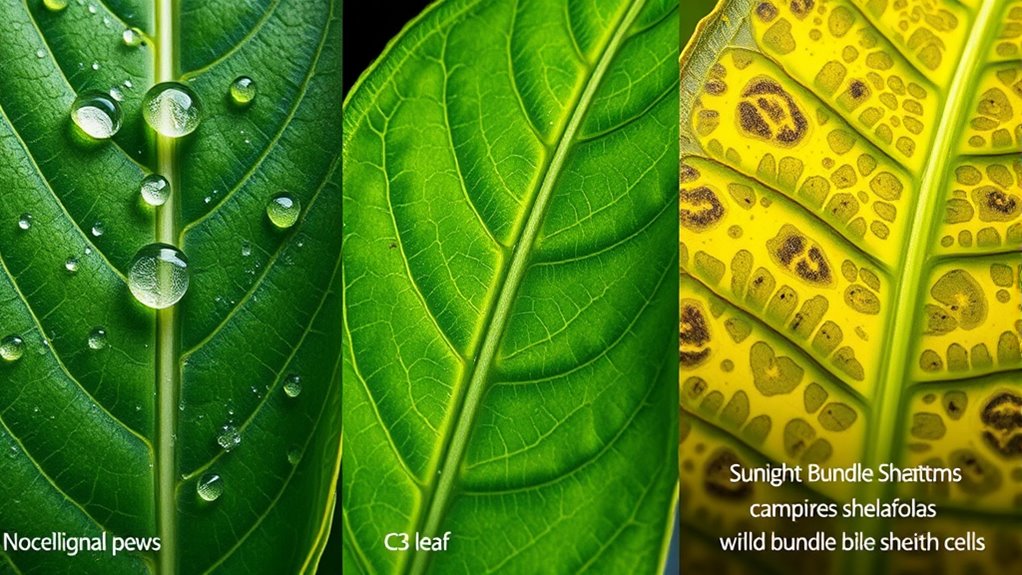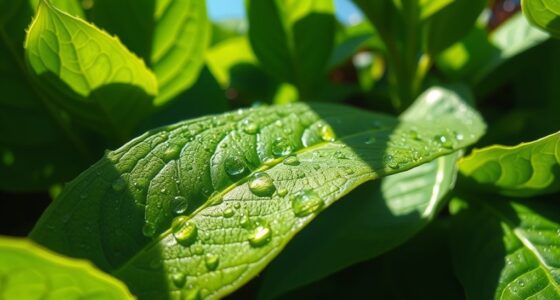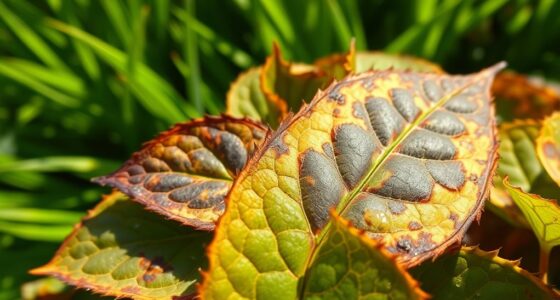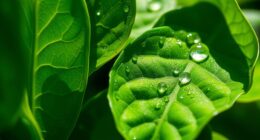Understanding CAM, C3, and C4 photosynthesis pathways helps you see how plants adapt to their environments. C3 is common but struggles in hot, dry conditions. C4 separates CO₂ fixation and the Calvin Cycle, making it more resilient in intense sunlight. CAM conserves water by fixing CO₂ at night, ideal for deserts. Recognizing these differences reveals how plants balance energy and water. Keep exploring to uncover how these pathways impact ecosystems and agriculture.
Key Takeaways
- C3, C4, and CAM are distinct photosynthesis pathways evolved to optimize energy use and water conservation in different environments.
- C3 is most common, but less efficient in hot, dry conditions, while C4 and CAM adapt better to such stresses.
- C4 separates CO₂ fixation and the Calvin Cycle spatially, reducing photorespiration in high temperatures.
- CAM allows plants to fix CO₂ at night, minimizing water loss in arid environments like deserts.
- Understanding these pathways aids in improving crop resilience, conserving ecosystems, and addressing climate challenges.

Photosynthesis pathways are the biological processes that plants, algae, and certain bacteria use to convert light energy into chemical energy. Among these, the C3, C4, and CAM pathways each represent adaptations that help organisms survive in different environments. If you’re exploring how plants thrive under various conditions, understanding these pathways reveals how they optimize photosynthesis and conserve resources. The C3 pathway is the most common, found in most plants, and it involves a straightforward process where CO₂ is directly fixed into a three-carbon compound. While efficient under moderate conditions, C3 plants tend to struggle in hot, dry environments because their efficiency drops when water becomes scarce or temperatures rise. That’s where the C4 pathway comes into play, offering greater resilience. C4 plants separate initial CO₂ fixation and the Calvin Cycle spatially, which reduces photorespiration—a wasteful process that hampers photosynthesis in high temperatures. This adaptation boosts resilience, allowing these plants to perform better in intense sunlight and arid conditions. You’ll find C4 plants like maize and sugarcane thriving in such environments, highlighting their resilience and making them critical for agriculture in challenging climates. Then there’s CAM photosynthesis, which is uniquely adapted for survival in extremely arid environments, like deserts. CAM plants open their stomata at night to fix CO₂ into organic acids, storing it until daylight when photosynthesis occurs. This adaptation minimizes water loss, making CAM highly efficient in conserving moisture. While CAM plants typically grow slowly, their ability to endure harsh droughts underscores their evolutionary significance. Their specialized mechanism illustrates how plants can develop unique solutions to environmental stresses that other pathways can’t handle as effectively. Overall, these pathways aren’t just different biological tricks—they tell a story of evolution and survival. The C3 pathway’s efficiency laid the groundwork for most plant life, but as conditions became harsher, the C4 pathway emerged, offering increased resilience in hot and dry habitats. Meanwhile, CAM evolved to thrive in environments where water is limited, exemplifying extreme adaptation. Your understanding of these pathways reveals how plants have evolved to optimize energy capture, maximize survival, and adapt to distinct climates. Each pathway’s unique traits contribute to the planet’s biodiversity and agricultural productivity, making their study crucial for addressing food security and ecological conservation. Whether in lush fields or desert landscapes, these photosynthesis pathways demonstrate nature’s incredible capacity to evolve solutions tailored to specific environmental pressures, ensuring life persists across the globe.
Frequently Asked Questions
How Do CAM, C3, and C4 Plants Differ in Water Efficiency?
You might wonder how these plants differ in water efficiency. Generally, CAM plants conserve water by opening their stomata at night, reducing water loss during hot days. C4 plants are more efficient than C3 because they minimize photorespiration, boosting photosynthesis efficiency and water use. This means CAM plants excel in dry environments, while C4 plants strike a balance, offering better water conservation than C3 species, making them well-suited for arid conditions.
Which Photosynthesis Pathway Is Most Common Among Plants?
Imagine a vast green tapestry stretching across landscapes—that’s the diversity of plant life. Among these, C3 plants are the most common, representing the original photosynthesis evolution. Their adaptation to temperate environments makes them widespread, much like a familiar melody. You can see how this pathway’s efficiency in normal conditions has allowed it to flourish, highlighting its crucial role in the ongoing story of plant adaptation and survival.
Can Plants Switch Between Different Photosynthesis Pathways?
You might wonder if plants can switch between photosynthesis pathways. While most plants stick to their initial pathway, some show photosynthesis flexibility through pathway adaptation. This means they can adjust their processes based on environmental conditions, like drought or high temperatures. Although full switching is rare, certain plants can modify their photosynthesis methods to optimize energy production and water conservation, demonstrating a remarkable ability for pathway adaptation.
How Do Environmental Conditions Influence Pathway Selection?
Imagine plants choosing their photosynthesis strategy like picking an outfit for the weather—ironic, isn’t it? Environmental triggers like drought, high temperatures, or low CO₂ levels influence their adaptation strategies. These conditions push plants to switch pathways to optimize water use and energy efficiency. So, you see, nature’s cleverness lies in its ability to adapt, ensuring survival amid ever-changing environmental cues.
What Are the Agricultural Implications of These Different Pathways?
You should consider that different photosynthesis pathways impact crop adaptation and sustainable farming practices. By understanding these pathways, you can choose crops better suited for specific environmental conditions, improving yield and resource efficiency. This knowledge helps you develop sustainable farming methods that reduce water and energy use, making agriculture more resilient. Ultimately, selecting the right pathway for your crops supports long-term productivity and environmental health.
Conclusion
Imagine standing in a lush, sunlit forest, feeling the warm rays dance on your skin. Just like the trees adapt with CAM, C3, and C4 pathways to thrive in different environments, understanding these processes helps us protect our planet’s green lungs. By knowing how plants breathe and grow, you become part of the bigger picture—ensuring future generations can enjoy vibrant ecosystems. Embrace this knowledge, and help nurture the world’s natural life support system.










